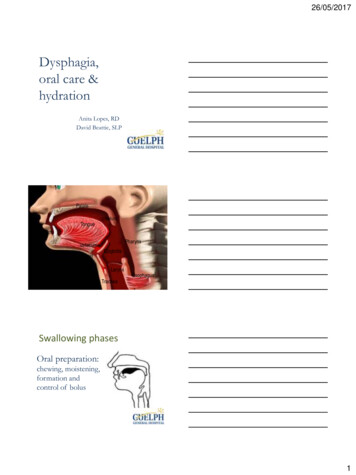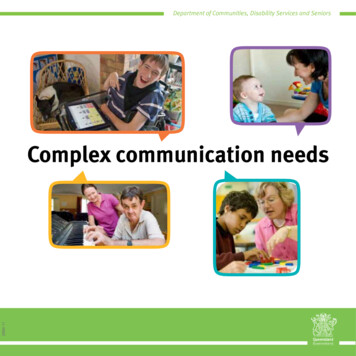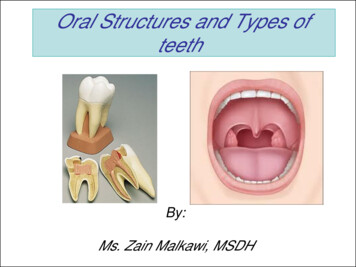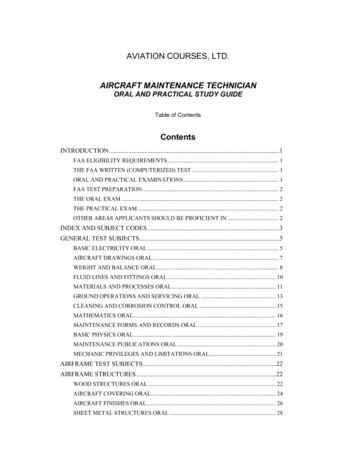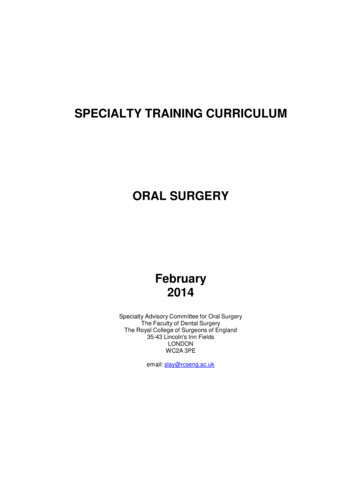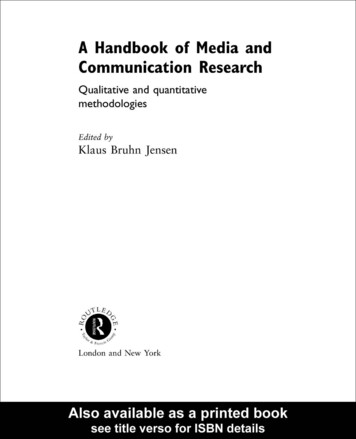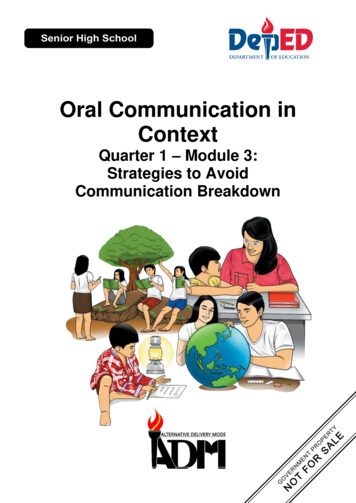
Transcription
Oral Communication inContextQuarter 1 – Module 3:Strategies to AvoidCommunication Breakdown
Oral Communication in ContextAlternative Delivery ModeQuarter 1 – Module 3: Strategies to Avoid Communication BreakdownFirst Edition, 2020Republic Act 8293, section 176 states that: No copyright shall subsist in any work of theGovernment of the Philippines. However, prior approval of the government agency or officewherein the work is created shall be necessary for exploitation of such work for profit. Suchagency or office may, among other things, impose as a condition the payment of royalties.Borrowed materials (i.e., songs, stories, poems, pictures, photos, brand names, trademarks,etc.) included in this module are owned by their respective copyright holders. Every effort hasbeen exerted to locate and seek permission to use these materials from their respectivecopyright owners. The publisher and authors do not represent nor claim ownership over them.Published by the Department of EducationSecretary: Leonor Magtolis BrionesUndersecretary: Diosdado M. San AntonioDevelopment Team of the ModuleWriter: Jhon Jhon P. Zotomayor; Fely Rose M. NacarioEditors: Marites M. Aguilar; Rizza A. PereyraReviewer: Liza L. Banayo; Lea C. Villegas; Leilani J. Miranda; Erma S. Valenzuela;Jhonathan S. CadavidoIllustrator: Joseph O. OcfemiaLayout Artist: Allan E. MedenillaManagement Team:Regional Director: Wilfredo E. CabralCLMD Chief: Job S. Zape Jr.Regional EPS In Charge of LRMS: Eugenio S. AdraoRegional ADM Coordinator: Elaine T. BalaoganSchools Division Superintendent/s: Edna Faura-Agustin; Marites A. IbañezAssistant Schools Division Superintendent/s: Nicholas M. Burgos;Edgardo B. Militante;CID Chief/s: Mary Ann L. Tatlongmaria; Orlando T. ValverdeDivision EPS/s In Charge of LRMS: Evelyn P. De Castro; Godofredo C. MercadoPrinted in the Philippines byDepartment of Education – RegionIV-A CALABARZONOffice Address:Telefax:E-mail Address:Gate 2 Karangalan Village, Barangay San IsidroCainta, Rizal .gov.phii
Oral Communicationin ContextQuarter 1 – Module 3:Strategies to AvoidCommunication Breakdowniii
Introductory MessageFor the facilitator:Welcome to the Oral Communication in Context Grade 11/12 Alternative Delivery Mode (ADM)Module on Strategies to Avoid Communication Breakdown!This module was collaboratively designed, developed and reviewed by educators both frompublic and private institutions to assist you, the teacher or facilitator in helping the learnersmeet the standards set by the K to 12 Curriculum while overcoming their personal, social, andeconomic constraints in schooling.This learning resource hopes to engage the learners into guided and independent learningactivities at their own pace and time. Furthermore, this also aims to help learners acquire theneeded 21st century skills while taking into consideration their needs and circumstances.In addition to the material in the main text, you will also see this box in the body of the module:Notes to the TeacherThis contains helpful tips or strategies thatwill help you in guiding the learners.As a facilitator, you are expected to orient the learners on how to use this module. You alsoneed to keep track of the learners' progress while allowing them to manage their own learning.Furthermore, you are expected to encourage and assist the learners as they do the tasksincluded in the module.iv
For the learner:Welcome to the Oral Communication in Context Grade 11/12 Alternative Delivery Mode (ADM)Module on Strategies to Avoid Communication Breakdown!The hand is one of the most symbolized part of the human body. It is often used to depict skill,action and purpose. Through our hands, we may learn, create and accomplish. Hence, thehand in this learning resource signifies that you as a learner are capable and empowered tosuccessfully achieve the relevant competencies and skills at your own pace and time. Youracademic success lies in your own hands!This module was designed to provide you with fun and meaningful opportunities for guidedand independent learning at your own leap and speed. You will be enabled to process thecontents of the learning resource while being an active learner.This module has the following parts and corresponding icons:What I Need to KnowThis will give you an idea of the skills orcompetencies you are expected to learn in themodule.What I KnowThis part includes an activity that aims to checkwhat you already know about the lesson to take. Ifyou get all the answers correct (100%), you maydecide to skip this module.What’s InThis is a brief drill or review to help you link thecurrent lesson with the previous one.What’s NewIn this portion, the new lesson will be introduced toyou in various ways such as a story, a song, apoem, a problem opener, an activity or a situation.What is ItThis section provides a brief discussion of thelesson. This aims to help you discover andunderstand new concepts and skills.What’s MoreThis comprises activities for independent practiceto solidify your understanding and skills of thetopic. You may check the answers to the exercisesusing the Answer Key at the end of the module.What I Have aph to be filled in to process whatyou learned from the lesson.What I Can DoThis section provides an activity which will helpyou transfer your new knowledge or skill into reallife situations or concerns.AssessmentThis is a task which aims to evaluate your level ofmastery in achieving the learning competency.v
Additional ActivitiesIn this portion, another activity will be given to youto enrich your knowledge or skill of the lessonlearned. This also tends retention of learnedconcepts.Answer KeyThis contains answers to all activities in themodule.At the end of this module you will also find:ReferencesThis is a list of all sources used in developingthis module.The following are some reminders in using this module:1. Use the module with care. Do not put unnecessary mark/s on any part of the module.Use a separate sheet of paper in answering the exercises.2. Do not forget to answer What I Know before moving on to the other activities includedin the module.3. Read the directions carefully before doing each task.4. Observe honesty and integrity in doing the tasks and checking your answers.5. Finish the task at hand before proceeding to the next.6. Return this module to your teacher/facilitator once you are through with it.If you encounter any difficulty in answering the tasks in this module, do not hesitate toconsult your teacher or facilitator. Always bear in mind that you are not alone.We hope that through this material, you will experience meaningful learning and gain deepunderstanding of the relevant competencies. You can do it!vi
What I Need to KnowThis module was designed and written with you in mind. It is here to help youidentify various strategies that could be used in order to avoid communicationbreakdown. It will lead you to understanding how communication works amongpeople to foster mutual understanding and good relationship. The scope of thismodule permits it to be used in many different learning situations. The languageused recognizes the diverse vocabulary level of students. The lessons are arrangedto follow the standard sequence of the course. But the order in which you readthem can be changed to correspond with the textbook you are now using.This module is divided into two lessons, namely: Lesson 1: Communication Breakdown Lesson 2: Various Strategies to Avoid Communication BreakdownAfter going through this module, you are expected to:1. define the concept of communication breakdown;2. identify the different kinds of barriers to effective communication;3. explain the causes of communication breakdown; and4. use appropriate strategies to avoid communication breakdown and achievethe goals of relationship and community building.What I KnowA. Choose the letter of the best answer. Write your answers on a separate sheet of paper.1. It happens when the sender fails to communicate his/her message properly orwhen the intended message is not clearly understood by the receiver.A. communicationB. communication barrierC. strategies to avoid communication barriersD. process of communication2. It refers to the natural or environmental conditions that hinder a successfulcommunication transaction.A. cultural barrierB. external noiseC. physical barrierD. psychological barrier1
3. These are issues like trauma, lack of confidence, fear, anger, frustration, anddepression that may affect the communication process.A. external NoiseB. linguistic barrierC. psychological barrierD. semantic Noise4. It refers to the way a person responds in a communication situation affected bypersonal norms and traditions.A. cultural barrierB. linguistic barrierC. physical barrierD. psychological barrier5. This is an example when linguistic barrier to communication becomes evident.A. A professor explains his lessons eloquently in class.B. Elena is afraid to deliver her opening remarks.C. People do not understand each other’s language.D. The transmitter disrupted the speech of Ms. Speaker.6. This is one of the reasons why cultural diversity can make communication inefficient.A. Cultural diversity allows people to be unique and original.B. Different culture interpret words, gestures, and symbols differently.C. Traditions propagate through the preservation of norms and values.D. Values of people reflect7. It is the main cause of semantic noise.A. jeepneys beepingB. constructing buildingC. using excessive technical jargonD. people talking too loud8. Which best defines NOISE in the context of communication?A. It is the sound of karaoke from your neighbor.B. It is any sound that occurs during the communication process.C. It is a sound that blocks or interferes communication situations.D. It is anything that interferes with the communication.9.Which of the following is an example of psychological barrier?A. ability to read mindsB. dissatisfaction to customer serviceC. inattentiveness to detailD. poor listening skills10. Which factors are considered cultural barriers to communication?2
A.B.C.D.economic status, age, and genderethics, standards, and grammarpolitics, administration and governmentreligion, World Meanings, and Philosophy11. Why does communication breakdown occur?A. because the information is overloading.B. because of lack of attention among the audiences or receivers.C. because the listener or receiver has a very short attention span.D. All of the above12. Which does NOT belong to the group?A. external noiseB. internal noiseC. semantic noiseD. verbal noise13. “Mrs. Erlinda was invited as a speaker during the National Women’s Month.She talked about Gender Equality. She delivered her speech for almost 1hour with more than 50 slides. The audience appeared uneasy and seemeduninterested after 20 minutes.”What barrier of communication is evident in this situation?A. cultural barrierB. linguistic barrierC. physiological BarrierD. psychological Barrier14. Which communication situation displays physiological barrier?A. The General Parents and Teachers Association (GPTA) president feltnervous when he started to speak in front of all the parents andguardians.B. The Municipal Agriculture officer is discussing certain agriculturalcrops management procedure in a community that is not veryfamiliar with the topic.C. The newly designated general manager of the restaurant was a bithesitant to talk with the guests.D. The research teacher discusses with his students about the problemwhen a song was played loudly from the other classroom.15. WhichA.B.C.D.situation BEST exemplifies communication breakdown?adjusting your language depending on the people you are talking toincorrect labeling of handouts to be used in product distributionlistening to your friend’s heartaches and unsuccessful love storieslooking for the positive characteristics or strengths of a speaker3
LessonCommunicationBreakdown1In Module 2, you have learned about the models of communication. You haverealized how the different elements of communication work together to achieve asuccessful communication transaction. Now, let us find out if you can stillremember your previous lesson by answering the activity below.What’s InDirections: Put the phrases or statements in the correct column. Write the letterof your answer on a separate sheet of paper.Linear ModelInteractiveTransactional ModelA. Schramm Model of CommunicationB. Shannon Weaver Model of CommunicationC. a two-way communication process where feedback is given after amessage is sent.D. shows circular process between the sender and receiver.E. barriers affect the smooth flow of communicationF. a one-way communication process.G. having a job interviewH. reciting a poem in front of the classI. presiding an important meetingJ. focusing on the message sent.4
What’s NewCommunication is a process of exchanging thoughts, ideas, and opinions in orderto connect with other people. It’s goal is to achieve a clear and effectiveunderstanding resulting to good relationships in the community. However, thereare times when this goal is not reached due to certain factors. When this happens,there is communication breakdown.Directions: Identify the reasons for the communication breakdown in eachpicture. Write your answer in a separate sheet of paper similar to the box below.5
What is ItThe elements involved in communication are important in the success or failure ofthis process. These very same elements (sender, message, receiver, feedback, etc)can pose a threat to the efficiency or effectiveness of the process. Communicationbreakdown may occur when problems in any of the elements involved arise. Theybecome barriers to communication.Simply put, communication breakdown results when the intended message of thesender is not understood exactly by the receiver. Barriers to communication arepresent.Recognizing the barriers or obstacles to effective communication is important inorder to avoid communication breakdown. Here are some of the barriers that maycause communication failure.Barriers to CommunicationPhysical Barriers are the natural or environmental condition that act as abarrier in communication in sending the message from sender to receiver.Examples:1. People talking too loud.2. Noise from a construction site3. Loud sound of a karaoke4. Blaring of jeepney hornsPsychological Barriers are called as mental barriers. These refer to social andpersonal issues of a speaker towards communicating with others.Examples:1. trauma2. shyness, lack of confidence3. depression4. fear, stage frightCultural Barriers pertain to communication problems encountered by peopleregarding their intrinsic values, beliefs, and traditions in conflict with others.People’s culture affect the way they communicate and relate to othersExamples:1. different beliefs2. traditions, and customs3. manners of dressing4. speaking6
Linguistic Barriers pertain conflicts with regard to language and wordmeanings. Because words carry denotative and connotative meanings, they cansometimes cause confusion and misunderstanding. Meaning of words andsymbols also vary depending on culture.Examples:1. difference in language2. accent and dialect3. use of jargon and slang4. speech defects or language impairmentsVerderber (1991) gives a similar idea of barrier when he classifies noise into threekinds: External, Internal and Semantic noise.External Noises are the “sight, sound and other stimuli thatdraw people’s attention away from intended meaning.”Examples:1. noise from vehicles2. singing at the neighborhood3. visual aids in front of the classroom4. the dog barking5. the sound of airplaneInternal noises are the “thoughts and feelings that interfere withmeaning.”Examples:1. confrontation with a friend2. fear of speaking in front of the class.3. racial prejudiceSemantic noises are the “alternate meanings aroused by a speaker’ssymbols.” This idea means that a word may have another meaning inthe minds of the students. This is affected by the language in whichthey grew and the culture in which they are exposed.Examples:1. incorrect grammar2. using excessive technical jargon3. using idiomatic expressions7
What’s MoreActivity 1Directions: Identify the kind of communication barrier exemplified by eachdescription. Tell whether it is Physiological, Psychological, Cultural, or LinguisticBarrier. Write your answer on a separate sheet of paper.1. lack of confidence2. connotative and denotative meaning3. loud party4. different races5. poor lighting6. lack of interest and attention7. different views and opinions8. using idiomatic expressions9. information overload10. feel frustratedActivity 2Directions: Explain why there is communication breakdown on the givensituations. Again, write your answer on a separate sheet of paper.1. Jay and Michelle started talking about their plans for Christmas Vacationwhen their classmate, Moy, interrupted them.2. “Mama, I will buy this cake for you. I am very sure that you will like its taste.It’s from our favorite cake store!”3. You spent the night thinking and analyzing why a student from anotherclass talked to you on your way home.4. Livy encounters a participant who is very eager to share with others herviews and opinions. She does this without asking permission.5. In some Asian countries, direct eye contact is considered disrespectful andrude. In others, it is a must.8
What I Have LearnedDirections: Answer the following questions. Write your answer on the separate sheetof paper.1. What is communication breakdown?2. What are the barriers to communication?3. Why does breakdown of communication occur?What I Can DoInterview three (3) people and ask them about a past communication breakdownthey have experienced and what were the causes.1.1. Complete the table by answering the following questions:a. Who were the persons involved?b. What was the situation?c. When did the communication breakdown happen?d. What were the barriers to communication?e. What happened due to the communication breakdown?1.2Identify the cause of the communication breakdown.An examplePersonsInvolvedAlingCelia andReysa(Mother &Daughter)is provided for you:SituationTime ofCommunicationAling CeliaWhen Reysa wasasked Reysa watching herto wash the favorite animedishes.series9Barrier/s toCommunicationPhysiologicalBarrierResultAling Celia wasupset becauseReysa did notdo as told.
What was the cause of communication breakdown?Reysa’s lack of attention caused the communication breakdown.Now, do the following on your own. Interview someone in your home, school andcommunity. Copy the table on a separate sheet of paper and supply the neededinformation.PersonsInvolvedSituationTime ofBarrier/s toCommunication CommunicationResultWhat was the cause of the communication breakdown?AssessmentChoose the letter of the correct answer. Write your answers on a separate sheet ofpaper.1. What influence thecommunication?A. environmentB. language2. eC. noiseD. technological gadgetsis the communication process complete?when the message enters the channel of communicationwhen the receiver understands the message and feedbackwhen the sender transmits message to the receiverwhen the sender transmits the message successfully3. Which of the following must be avoided in communication breakdown?A. AmbiguityC. personal interpretationB. focused attentionD. Both A and B10
4. Which barrier includes the mental conditions of the listener?A. cultural barrierC. physical barrierB. linguistic barrierD. psychological barrier5. Which barrier includes the hearing or sight problem of the listener?A. cultural barrierC. physical barrierB. linguistic barrierD. Both A and C6. In which barrier can semantic noise be classified?A. cultural barrierC. physical barrierB. linguistic barrierD. Both A and C7. Which of the following must the listener do to avoid mental noise?A. Be ready for the communication activity.B. Be attentive and respond to the speaker.C. Just remain quiet and daydreamD. Must not think of any problem during class hours8. In which barrier does gender be classified in communication?A. cultural barrierC. Physical barrierB. linguistic barrierD. Both B and C9. Which is the best option in order to avoid misinterpretation that causescommunication barrier?A. Be familiar with the topic of the speaker.B. Disconnect with your emotional baggage.C. Do not be conscious of gender or status.D. Inquire the meaning.10. What is the barrier to which you classify withdrawal of listener?A. cultural barrierC. physical barrierB. linguistic barrierD. psychological barrierFor numbers 11-15, write T if the statement is TRUE and write F if it is FALSE.1. Inability to understand a message causes failure incommunication.2. The actual message is lost in transmission.3. Emotional problems can sometimes color one’s understanding ofa message.4. Culture may affect the interpretation of meaning incommunication.11
5. Pictures, gadgets, and other paraphernalia in front of the stageengage the audience in listening to the speaker.Additional ActivitiesChoose between offline activity or online activity.For Offline ActivityWrite a letter to your teacher about your personal learning on communicationbreakdown. Include in your letter, how this lesson can be useful in your daily lifeparticularly at home, in school, and in the community.Rubric for Writing a t(5 points)Show verymeaningfulcontent,explanationand relationto real-worldcontextSentencestructuresare well defined,accurate, andclear with nospelling,punctuationand grammarerrors.Ideas are verywellorganized,coherenceand cohesionare veryevident.Poor(2 points)NeedsImprovement(1 point)No detailsprovidedNo evidence oforganization ofideas.VeryGood(4 points)Good(3 onEnumeratessignificantpointsrelated tothe topicInsignificanterrors insentencestructure,grammar,spelling andpunctuationare noted.A few errorsin sentencestructure,grammar,spelling andpunctuationare noted.Lacksevidencethatconnect totheprovidedtopicSome errorsin sentencestructure,grammar,spelling andpunctuationare present.Ideas arefocused anddirected.Ideas areslightlyorganizedIdeas arelooselyorganized.ScoreTotal Score/ 15 points12Sentencestructure isincorrect,grammar ispoor, anderrors inspelling andpunctuationabound
For Online ActivityCreate a 5 Minute Vlog about communication breakdown. Be sure that thedefinition and explanation why there is a communication breakdown are evidentin the video. Send the link of your presentation to your teacher.Rubric for Creating a tal ScoreExcellent(5 points)VeryGood(4 points)Poor(2 points)NeedsImprovement(1 point)Presentsaccurate,completeand wellexplainedideasrelated tothe topicInformation, video,picturesand othercontent arevery wellorganized,andcoherenceandcohesionare veryevident.Visuals arewellframed andaudioorsoundquality isexcellentandsuitablethroughout.Presents ideasstronglyconnected tothe giventopicPresents ideasin relation tothe given topicLacksevidence thatconnectpresentationto theprovided topicNo connectionto theprovided topicInformation,video,pictures andother contentare focusedand directed.Information,video, picturesand othercontent areslightlyorganizedInformation,video, picturesand othercontent arelooselyorganized.No evidence oforganizationofinformation,video, picturesand othercontent.Visualsaremaintainedand audio orsound intained inmost parts andaudio or soundqualityareunderstandableandappropriate.also in mostparts.Visualsaremaintained ina few parts andaudio or soundqualityareunderstandableandappropriate.also in mostparts.Visualsarenot in manypartsandaudioorsound qualityarepoorthroughout.Good(3 points)/ 15 points13
14Assessment1. C2. B3. D4. D5. B6. B7. B8. A9. B10. B11. True12. False13. True14. True15. FalseWhat I have learned1. Communication Breakdownhappens when the transmittedmessage is not understoodexactly by the receiver2. Physiological, Psychological,Cultural, Linguistic,3. Answers may varyWhat I Can Doanswers may varyWhat’s NewAnswers may varyWhat's MoreActivity 11. Psychological2. Linguistic3. Physiological4. Cultural Barrier5. Physiological Barrier6. Psychological7. Cultural8. Linguistic9. Psychological10. PsychologicalActivity 2Answers may vary1. B2. C3. C4. A5. C6. B7. C8. D9. B10. A11. D12. D13. C14. D15. BTransactional ModelDEIWhat I KnowWhat’s InLinear ModelBFHJInteractiveACGAnswer Key
What I KnowChoose the letter of the correct answer. Write your answers on a separate sheet ofpaper.1. It takes place when the shared information is mutually understood.A. barriers to communicationC. effective communicationB. communicationD. strategies to effectivecommunication2. It refers to the use of appropriate speaking volume, rate, acceptablepronunciation, and proper stressing.A. keep focusedC. minimize distractionsB. listen with your ears and eyesD. speak intelligently3. It helps to pay attention to the verbal message as well as the nonverbalmessage.A. keep focusedC. minimize distractionsB. listen with your ears and eyesD. speak intelligently4. It uses concise and simple words to deliver the message.A. be specificC. minimize distractionsB. do not jump to conclusionsD. speak intelligently5. It is important for a receiver to analyze first the message of the sender beforehe/she accepts or reject them.A. barriers to communicationC. do not jump to conclusionsB. be specificD. effective communicationFill each blank with the correct word, phrase, or clause to complete the statement.Choose the letter of the correct answer and write it on a separate sheet of paper.6. Complete communication is to the quality of the communicationprocess in general.A. essentialC. partB. neededD. reliable7. is making the message direct and straight to the point.information should be eliminated from the communication thatwill be sent to the recipient.A. Clarity significantC. Concreteness insignificantB. Conciseness insignificantD. Courtesy significant8. In order to be an effective speaker, you should always significantinformation about your receiver’s mood, race, background, preferences,education, and others.15
A. considerB. holdC. rateD. think9. Concrete message is supported by facts, figures, and real life examples. Thiswill make the receiver to .A. develop rapport to the speaker.B. realize the importance of communication process.C. respond quickly to the message.D. understand the message better.10. As a speaker, you want to deliver a clear message to the audience or receiver.Therefore, you will .A. know their background informationB. include everything in your messageC. respect their culture, values, and beliefsD. use of simple and specific words to express ideasChoose the letter of the correct answer. Write your answers on a separate sheet ofpaper.11. Which of the following shows positive feedback or remark?A. You cooperate consistently with your team members.B. You display concerned about the other’s job so often but not yours.C. You show dishonesty in working among with your colleagues.D. You urge to distract everyone in the office.12. Which of the following display the best question and show politeness inasking for repetition?A. Could you be more specific?B. I don’t understand what you said. Could you say it again?C. Will you please repeat the instruction?D. Both A and B13. Which of the following does NOT show polite expression?A. May I borrow your pen for a moment?B. Order me a coffee.C. Perhaps I’m not making myself clear.D. Tell me, when you are available.14. Which is NOT a time-gaining expression?A. “Anyway”B. “Sounds good”C. “Tell me more.”D. “Uh-huh”15. Which is the BEST expression for asking for a repetition?A. I’m sorry, would you mind saying that again.B. Sorry, I didn’t get your point.C. Sorry, let me explain.D. What do you mean by that?16
Lesson2Various Strategies to AvoidCommunication BreakdownWhat’s InIn Lesson 1, you have learned the concept of communication breakdown and itscauses. In this lesson, you will find out how this breakdown of communication canbe avoided.Directions: List down two (2) to three (3) situations based on your What I Can DoActivity in Lesson 1 in which communication breakdowns were experienced athome, school, and community. Then, suggest one best strategy to avoid thatcommunication breakdown.Example:Breakdown: The DOST scholar uses technical words in explaining his research tothe barangay officials which resulted to confusion among them.Strategy: The DOST scholar should uses simple and specific words about hisresearch to the barangay officials so they would easily understand his message.Scenarios where CommunicationBreakdown occurredStrategies to Avoid CommunicationBreakdown17
What’s NewCommunication breakdown may at times be inevitable but as a sensible speakeror sender of the message, we could avoid this. Understanding the concept ofcommunication breakdown and its causes, will help us realize that failure incommunication may be avoided through certain strategies that we could adapt.Here is an article entitled 5 Ways to Avoid Communication Breakdown by RonniePeterson.5 Ways to Avoid Communication Breakdownby Ronnie PetersonCommunication breakdown can cause issues or problems at home, school, andcommunity. There are so many barriers to communication like, physiological,psychological, cultural, and linguistics.Sometimes some communication barriers are too difficult to solve and this willlead to slowing the progress and efficiency.Here are the possible strategies to avoid communication breakdown:1. Have Clarity of thought before speakingArrange your thoughts before verbalizing them this can h
Answer Key This contains answers to all activities in the module. At the end of this module you will also find: The following are some reminders in using this module: 1. Use the module with care. Do not put unnecessary mark/s on any part of the module. Use

